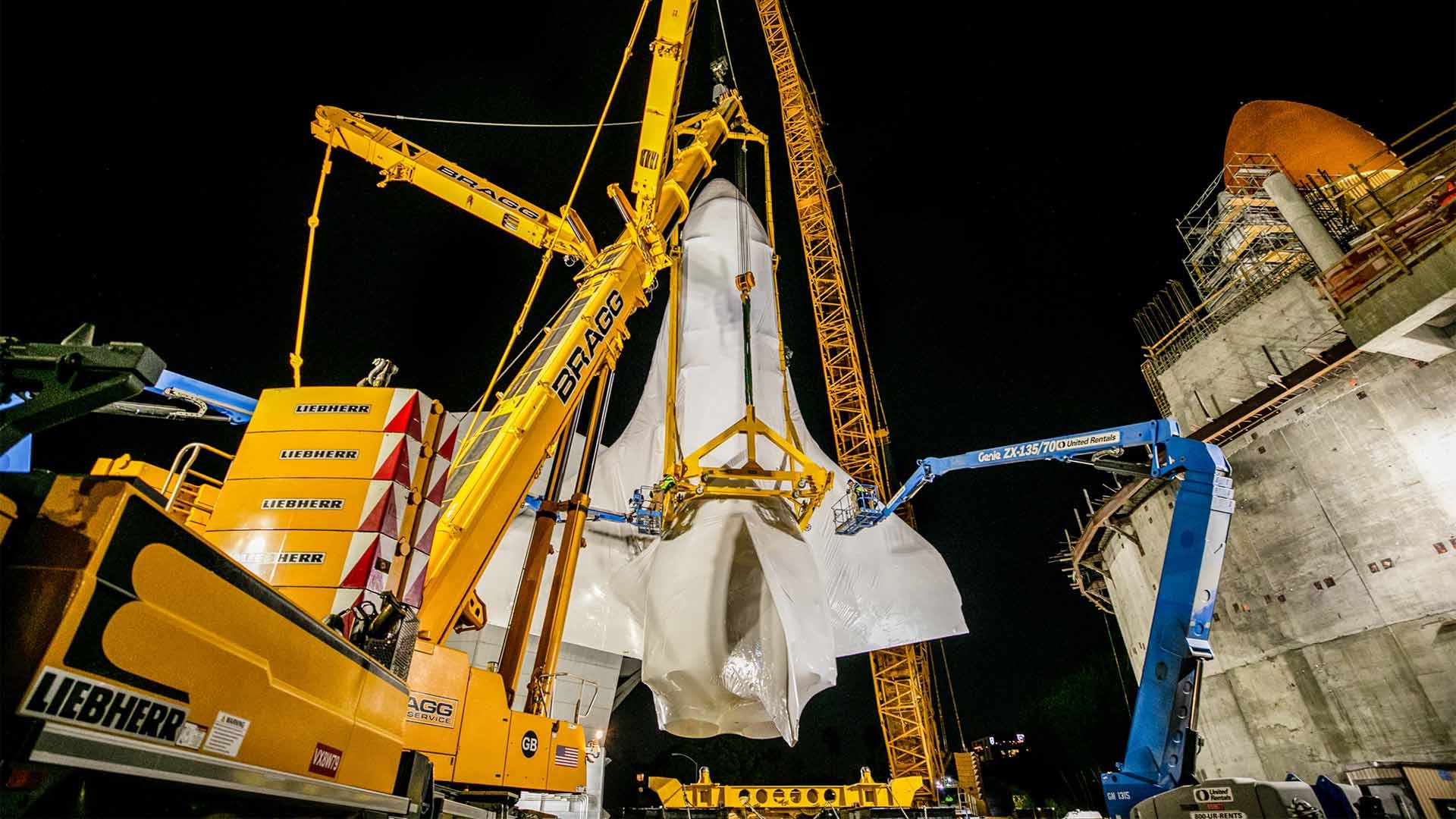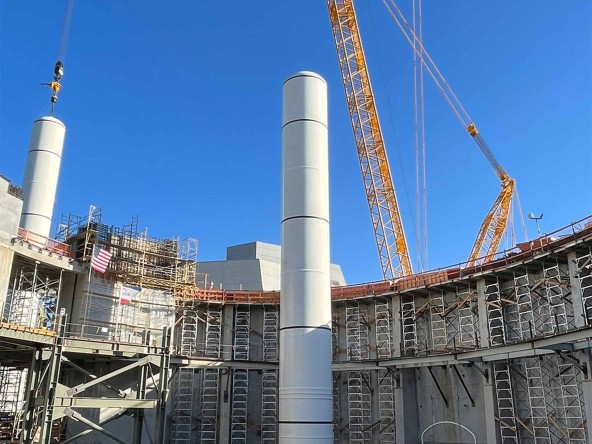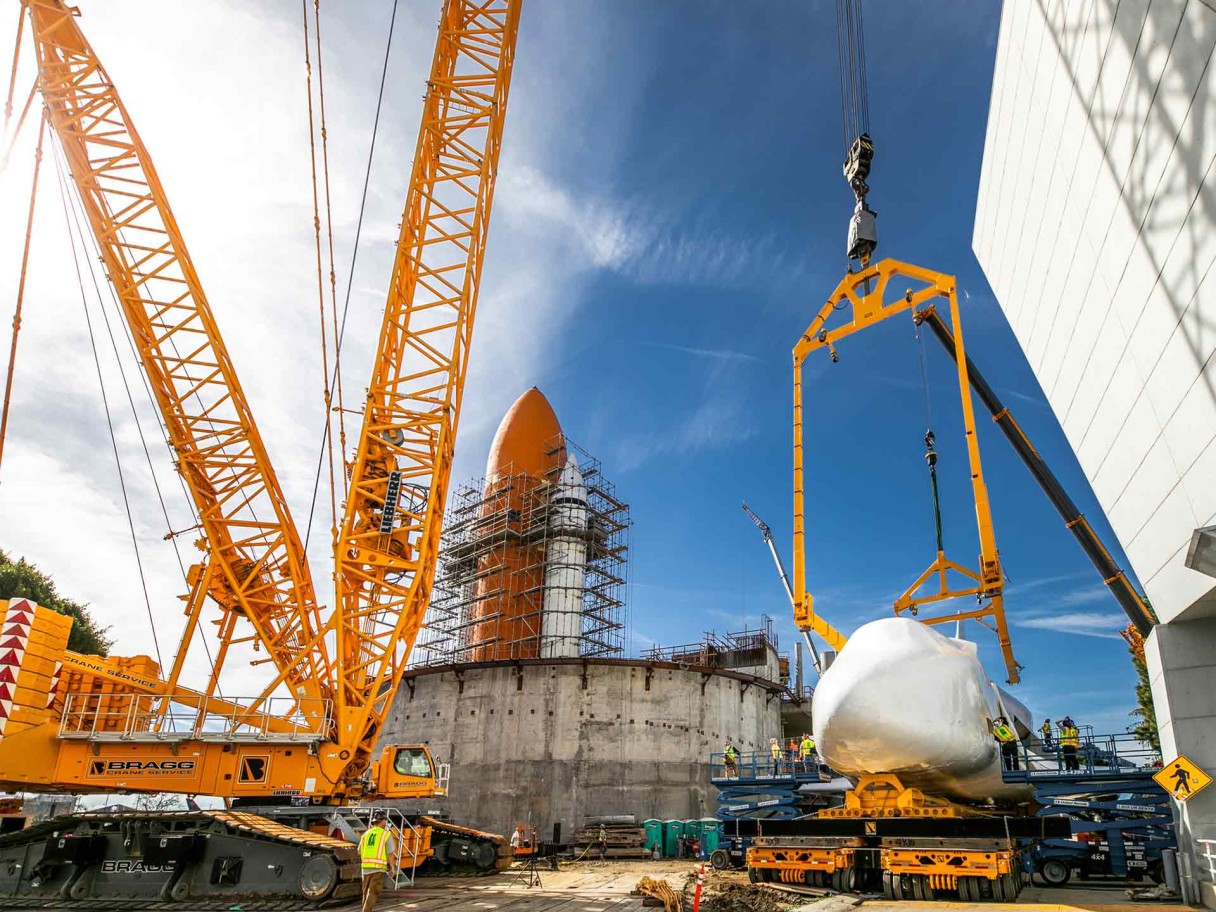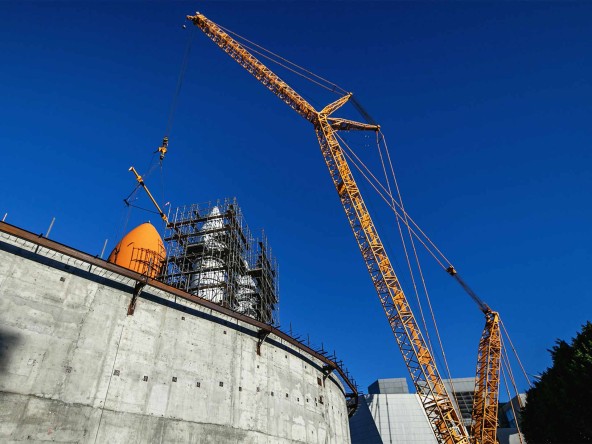
6 minutes - magazine 01 | 2025
Lift-off in Los Angeles
25 missions, 299 days in space and an unimaginable 198 million kilometres travelled – we’re talking about the space shuttle Endeavour. After 20 years in the service of US space travel, the historic space shuttle finally ended its space career in 2011 and has since delighted over 20 million visitors from all over the world at the California Science Center in Los Angeles – albeit in a horizontal position.
Liebherr cranes move space shuttle into launch position
The Endeavour has now embarked on what is expected to be its final journey to a new exhibition area of the museum. The exhibit was set up in a 100,000-square-metre exhibition space at the Samuel Oschin Air and Space Center in a ready-to-launch “liftoff” position. Several Liebherr cranes were used to assemble all the components of the 20-storey space shuttle. This makes the Endeavour the only space shuttle system in the world to be exhibited in an authentic launch configuration.

Lift of the solid-fuel rockets onto the mounted aft skirts.
Complex assembly process
In order to realise a project of this size, precise planning in advance was essential: it took the Californian crane and heavy lifting company Bragg Companies more than 6,000 working hours, including 1,400 hours for planning the lifts, 20 technical plans and a good two years of construction preparation to complete the entire space shuttle system. The complex process to bring the individual components into the starting position took six months and began in July 2023 with the transport of the aft skirts from Mojave, California, to Los Angeles. From here, the Liebherr LR 1750/2 crawler crane, which was equipped with a counterweight of 665 tonnes, took over. With a maximum radius of 46 metres and a lifting height of 120 metres, the aft skirts were placed in their final position in the building, which is still under construction. Bragg Companies provided the LR 1750/2 with an LTM 1160-5.2 mobile crane as an assistant for lifting the 46 metre long fuel tank, the largest component, and the solid fuel rockets. Both cranes demonstrated sensitivity and precision when lifting and setting down the components.
80 tonnes of history on the hook

On tour: Endeavour on its spectacular transport to the Samuel Oschin Air and Space Center building.
Last but not least, the centrepiece was inserted: with a weight of 80 tonnes, a length of 37 metres and a wingspan of 24 metres, the legendary space shuttle was the largest element to be manoeuvred. After a difficult and spectacular transport process through the streets of Los Angeles, Endeavour was lifted with the help of the LR 1750/2, righted and finally set inside the new building of the Samuel Oschin Air and Space Center. The crawler crane was supported in its painstaking work by two Liebherr mobile cranes: an LTM 1400-7.1 and an LTM 1160-5.2. The most difficult part of assembling all the units was attaching the external tank to the Endeavour. This had to be skilfully threaded through the scaffolding without coming into contact with other parts. In addition, the tight tolerances of the mating points to the solid rocket boosters made insertion difficult. After almost fourteen hours of highly concentrated work, the Endeavour was completely detached from the crane and finally positioned and assembled between the two solid rocket boosters and in front of the external fuel tank. Mission completed.
Justin Lambert, General Manager at Bragg Crane & Rigging, is delighted that the Orbiter has finally found a home and is very pleased with the performance of the Liebherr crawler crane: “The ability of the LR 1750/2 to electronically limit the lifting and slewing speed was crucial to the success of the lifting operations due to the extremely tight tolerances on site and the changing wind speeds.” Proud to have moved a piece of history, he adds: “When ʻflyingʼ priceless NASA artefacts like the Endeavour and its components, it’s reassuring to know you can rely on the quality, efficiency and accuracy of a Liebherr product.”

20 technical plans and over 1,400 hours of work for the perfect planning of the lifts.
Defying the weather
Strong winds and rain hampered the Bragg Companies team in their work. Due to the enormous dimensions of the flight components and the large surface areas, the lifting operations had to be carried out in the calmest wind conditions possible. These usually occurred in the early hours of the morning, so that several night shifts had to be put in to ensure that the complex lifts could be carried out safely. Despite all the challenges, the project was successfully completed without any incidents or significant damage.

With a counterweight of 665 tonnes, a maximum radius of 46 metres and a hoisting height of 120 metres, the LR 1750/2 positions historical components on site.
Launch pad for innovations
For the California Science Center, the arrival of the new exhibit is the fulfilment of a long-cherished dream. “With the lift and setting of the Endeavour, we have successfully installed the very last space shuttle. A dream that has been dreamt for over 20 years. And a tremendous feat that has never been done before outside of NASA or the Air Force,” explains Jeffrey Rudolph, President and CEO of the California Science Center, enthusiastically. The construction of the Samuel Oschin Air and Space Center is a significant expansion of the California Science Center. Once completed, the area will serve as a launch pad for creativity and innovation and inspire future generations of scientists, engineers and researchers. The 200,000-square-metre extension will almost double the exhibition space of the California Science Center and house an impressive collection of exhibits and artefacts. The museum is expected to be completed and open its doors to visitors in mid-2025.
This article was published in the UpLoad magazine 01 | 2025.



